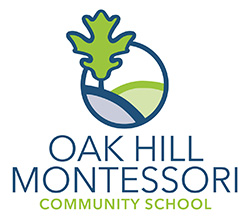Learning Model –
Oak Hill’s classrooms are separated into multi-aged environments.
Lower School
- Toddler Community – 16 months to approx. 34 months
- Children’s House (Pre-K) – approx. 34 months to 4 years
Upper School
- Children’s House (Kindergarten*) – Children must be 5 years old by September 1st of any school year to be considered for Kindergarten
- Lower Elementary(LE) – 1st – 3rd grade
- Upper Elementary (UE) – 4th – 6th grade
- Junior High – 7th & 8th grade
*As Kindergarten is part of the public charter school at Oak Hill, families interested in Kindergarten will need to re-apply for admission consideration.
You may follow the links to learn more about both our Lower School & Upper School programs.
We also invite you to enjoy the following video about the Montessori Approach.
Let’s Look at Assessment –
2023-24 Parent/Guardian Participation Guide and Refusal Information
Showing and Shaping Growth
In Montessori, we say that observation is our greatest form of assessment. Observation is the perfect way to evaluate the whole child. We can learn far more about a child by watching them and talking to them. Our teachers individualize instruction, follow the child, and offer a variety of areas of interest to the child. Children are provided with intervention and/or advanced work as their needs dictate.
While there are many different forms assessment can take, most of them can fit into two main categories: formative and summative assessment.
Formative assessment happens while the teaching and learning is taking place. This is the type that Montessori teachers rely heavily on. It allows teachers to shift gears mid-lesson and to get an instant record of how a child is doing with a particular skill at any given moment.
Summative assessment is more like your traditional test at the end of a unit, or a major standardized test at the end of the year. These tests are typically data collection points and prior to Junior High, are often used mostly by the adults and not to give feedback to the student.
Ultimately, testing is one tool among many that teachers can use to measure student learning. The data can be a useful tool for parents and teachers to see a snapshot in time of each child’s strengths and challenges as well as to examine the class’s data for needed changes to the curriculum.
Participation in the Minnesota Comprehensive Assessments (MCA’s) is required for all Public Schools in the State. These assessments are taken online and are a series of multiple-choice items intended to measure students’ progress toward meeting Minnesota’s academic standards.
To see OHMCS’ 2023-24 Assessment Calendar, please click here.
Self-Assessment
Montessori classrooms are not just designed for teachers to assess the students, but also for the students to assess themselves. This is done in two main ways.
Most Montessori materials are autodidactic, that is they are self-teaching. They have been intentionally developed in such a way that the child cannot complete the work incorrectly, or there is a built-in means for them to check their own work. When given a lesson on how to use a material correctly, the children learn about these built-in tools and how they can use them to guide their work.
Secondly, Montessori students are taught to be reflective. As they get older (typically elementary and above), individual meetings with their teacher give them the opportunity to be an active participant in planning their own education. They are not told what they must do, but they are asked how they plan to accomplish specific goals. Some of these goals are set by the teacher but others are set by the child. When needed, teachers will give strategies and suggestions, but the hope is that eventually the child will develop more of these on their own.
Children will eventually be able to look at their work and evaluate it with a critical eye, while experiencing the joy of accomplishment and learning. By not passing obvious judgment in the form of letter grades, Montessori children come to see their learning as a constantly fluctuating process that they are empowered by.
